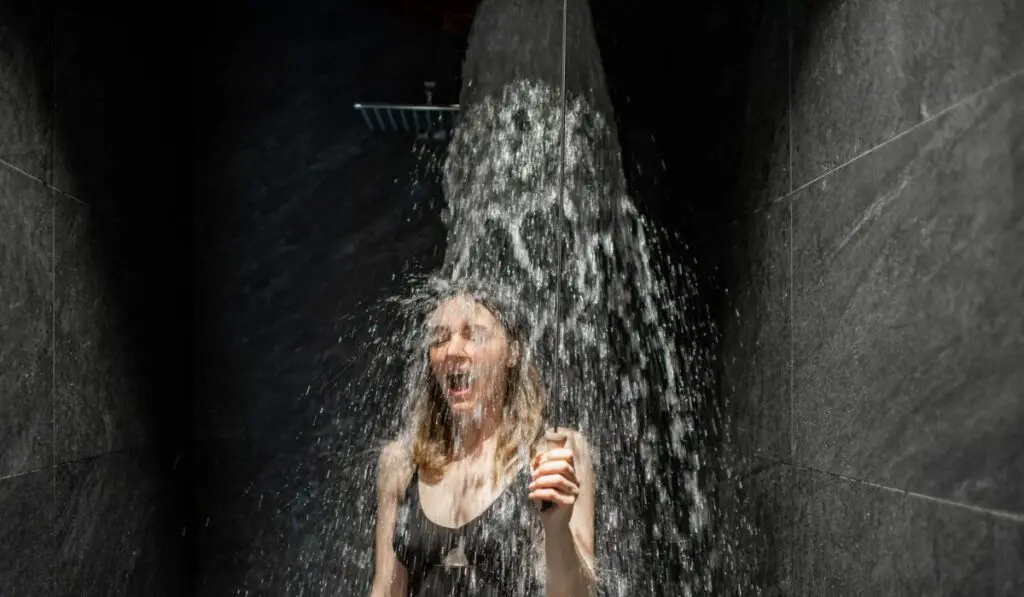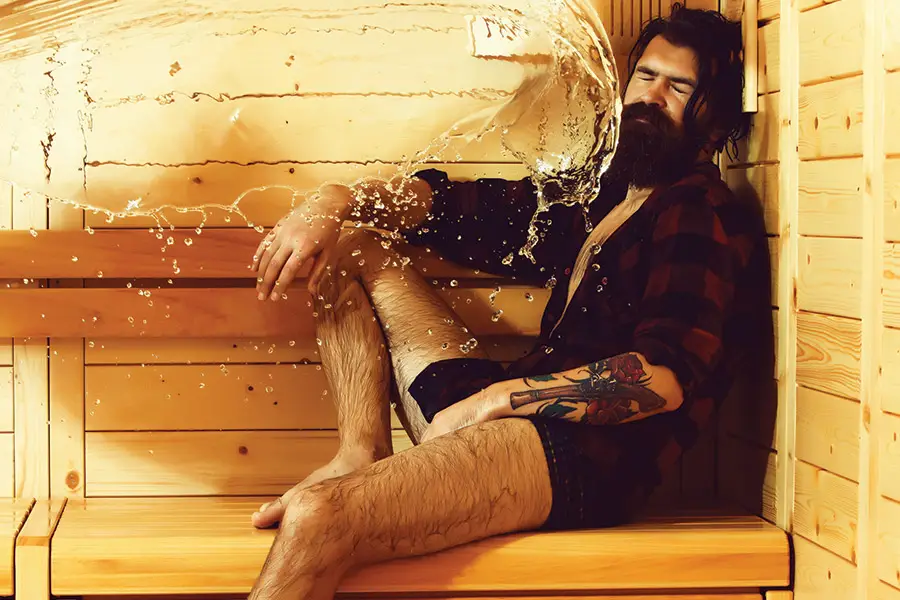Saunas are a great way to relieve stress, promote healthy circulation, and can help some people with weight management. In Nordic countries, where the sauna is an integral part of life, the hot sweat is often followed by a brisk dip into a polar ice bath. While this might shock the system and certainly wake you up, many people wonder what kind of health benefits there are going from hot to cold.
Cold showers are a great addition to any sauna session. Cold therapy following sauna use has origins that go back to traditional sauna use in areas like Finland. Going from hot to cold can reduce stress, help you get better sleep, and much more.
If you want to get the most out of your sauna sessions, should you add a cold portion? Doing this is easy enough for most people — a cold shower does just as well as an icy lake. You might be surprised to find out some of the health benefits of using this method. If you want to find out more and learn about whether cold showers after sauna are good for you, read on!
Is it Healthy to go from Sauna to Cold Shower/Cold Plunge?

Let’s jump right into it. Is it healthy to go from a steamy sauna or steam session (our guide) straight into a cold environment? This question gets right to the heart of what this article is about and what some sauna lovers practice regularly. Unfortunately, there has been little in the way of proper research into this subject.
But what researchers have looked into is cold water therapy. That’s really where we start getting into some hard science when it comes to this topic. Some research has also looked into how saunas affect our bodies and what health benefits we can use them for. Combine these, and you get a pretty good picture of what health benefits you might experience going from hot to cold.
The first thing we know for sure is what going from hot to cold does to our skin. While hot water is known to pull the lipids out of the skin, cold water can shut your pores. So if you want to clear your skin, the hot to cold plunge is a great way to freshen up your epidermis! There are some other health benefits too including inflammation help, for instance, icy-hot, improved blood flow, and soreness recovery.
As we’ve explained elsewhere on the site, there is also a ton of anecdotal evidence to support other claims like cardiovascular health benefits. Overall though, it is safe to go from a sauna session to a cold shower. Much like other practices, the key is to be moderate with both your sauna use and cold plunge. You don’t want to overdo it.
If you do have any concerns regarding your sauna use, make sure you contact your physician. Also, listen to your body. If things feel a bit too much, maybe the method isn’t right for you. This is especially the case if things like high blood pressure affect you. While there are no inherent dangers in the hot-cold plunge, it can be a shock to the system, so be careful.
Is Cold Therapy Good for You?
When it comes to cold water therapy, there is actually quite a bit that we do know. Not only has it been a preferred method for relieving soreness, but it has also, in some way or another, always been part of modern culture.
Cold showers, ice baths, outdoor swims, they all are a version of cold water therapy that we’ve been using for centuries. People claim that cold water therapy can help with circulation, deepen your sleep, give you extra energy and even reduce inflammation. So which of these are true, and which are just old wive’s tales?
Pain Relief and Inflammation
When it comes to muscle soreness, the research has shown us a pretty impressive picture. Athletes who use ice baths following excessive muscle exertion have less muscle pain after. Studies have proven this over and over again.
Medical professionals say that this happens because the cold water constricts your blood vessels, reducing swelling and inflammation. One note here is that you can combine cold therapy for muscle soreness with other forms of physical therapy. This means stretching and other forms of active recovery.
Better Sleep
Finding better sleep has almost been the holy grail for some people. Sleep is such an important part of how our bodies function. Miss a few hours, and you can feel it. Miss a few days? You might be out of commission until you can lay down again. So how can cold therapy in addition to magnesium glycinate tablets (on Amazon) help?
Some people argue that cold water therapy is exactly what you need if sleep is an issue. The idea is that the cold water will help relax your muscles and possibly your mind. Combine that with other ways to get good sleep, like exercise and eating well, and you might have the ticket to a great night’s rest.
Depression
Many people deal with anxiety and other mental health issues. While cold therapy certainly is no replacement for proper medical attention, some researchers have found it could help. One case study found that a program of open water swimming helps reduce reliance on medication.
The woman in the study attributed her new lease on life to the newly forged cold swimming habit. There was also research done on cold showers with individuals with depression. In addition to a healthy lifestyle, it’s not unreasonable to assume that these things together could really make a difference.
Immune System Boost
There is some evidence out there to suggest cold therapy is a way to bolster your immune system. This, in theory, can help you battle sickness. Basically, the idea is that there are some methods we can use to elicit a response from our immune system. There is research to back up cold water therapy and other methods.
In a study in question, researchers exposed participants to a bacterial infection. Using these therapies, including cold therapy, they were able to show fewer symptoms than the control group. Among these are things like meditation, deep breathing, and coldwater immersion.
Weight Loss
Don’t we all want an easy way to lose weight? While sauna use does have weight loss capabilities, what about cold water therapy? Although research is still ongoing in this realm, we do know cold water therapy can increase metabolism.
In this way, it can help you manage your diet better by burning calories faster. The idea behind this theory is your body will increase its metabolism in colder conditions. It does this to help preserve body heat so as to maintain homeostasis.
Mental Toughness
This benefit is certainly metaphysical, and there is no true way of knowing how it works. But, the idea that you can push your body to endure the uncomfortable cold can have permeating effects on your life. This is what some call mental toughness, or your ability to withstand uncomfortable situations.
As humans, we want to be comfortable. We’ll do all we can to be comfortable, actually. So training yourself to endure cold water could be seen as a step toward conquering the mind-body divide. Yes, it’s a bit out there. But if you can handle an extended dip in icy water, what can’t you handle?
Types of Cold Water Therapy
While you might think that a cold shower is all you need, there are a few types of cold water therapy to know about. If there is a situation where you are in cold water, that is a great way to experience cold water therapy. Some of the ways to get this therapy naturally include cold showers, ice baths, cold water plunges, and open water swimming.
How Long Should Your Cold Shower/Cold Plunge Be?

Before you start chopping up a hole in that frozen lake behind the barrel sauna, how long should your session be? This is a great question to ask if you want to get things right. Sure, there might not be tons of evidence out there supporting the hot-cold plunge, but people have practiced the method for years.
First, you’ll want to make sure your body cools down after your sauna. To experience the full effects of the cold water, you want to avoid diving right in. Give it just a few minutes for your skin to cool. After that, you’ll want to jump into the cold water.
As far as time goes, it’s really up to you and your chosen method. If you opt for a cold shower, stay in as long as it is comfortable. If you use the plunge method, a few seconds might do the trick. You don’t want to spend too much time in cold water as hypothermia is a real risk.
Ideally, you want a full 30-minute sauna session followed by a quick cold shower. If using the plunge method, substitute the shower for a quick plunge. No more than 15-20 seconds. Remember, you aren’t trying to punish your body. Listen to what it has to say and get out when it feels right.
Wrapping Up
Jumping into cold water after a sauna session can be beneficial. Not only do we know that cold water therapy has health benefits, but people have been using the method for years. This is especially the case for Nordic countries. Always listen to your body and consult your doctor if you have any questions.


